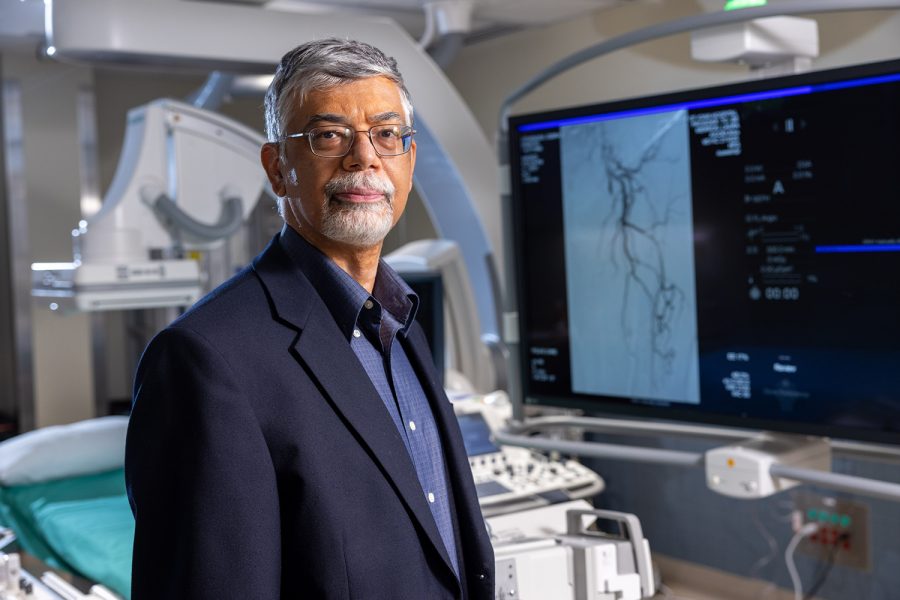New artificial intelligence developed for radiology at the UI
The goal of the radiology department is to supplement manpower and keep people healthy using artificial intelligence.
Liz Martin – Photographer – Univ
Dr. Sandeep Laroia, a practicing interventional radiologist, photographed in an IR suite on Friday, Oct. 7, 2022. Laroia is leading a group of researchers that recently earned a National Science Foundation Phase I grant to develop an artificial intelligence system that could assist with some interventional radiology procedures.
November 15, 2022
New artificial intelligence technology is being developed for radiology practices at the University of Iowa.
The team, led by interventional radiologist Sandeep Laroia, will use programmed medical information and input by physicians to pinpoint patients’ illnesses and determine the proper treatment for different medical issues. The technology will supplement manpower during a nationwide employee shortage and keep people healthy.
Multiple teams have assisted with the development of the project for about four years, Laroia said.
“The concept actually started even before COVID hit us — so, in 2018 to 2019,” he said. “So, we gathered a team, and the department was quite supportive in this initiative. Then, during COVID time, we realized that this can be made into something really useful and really helpful.”
Laroia said AI in medicine serves two main functions: reducing manpower and keeping employees safe.
As of July 2022, hospitals in almost 40 states reported critical staffing shortages. Laroia said AI will serve a crucial function by filling gaps created by the shortage
“In the medical field, there are very highly complex procedures like neurosurgery or tumor surgery and things like that, but there are many tasks which do not need that high amount of expertise and training,” Laroia said. “It frees up the manpower to do things machines can’t do.”
Hozhabr Mozafari, a licensing associate at the UI Research Foundation, is working with Laroia’s team to bring their product to market by filing patents and copyrights and pitching the product to consumers.
“There is a lot of back and forth here, discussions and meetings with the company, and if they’re interested, we’d license that,” he said. “Basically, our main mission is for those companies to manufacture our [intellectual property] so the public can benefit from it.”
The team has filed multiple patents for Laroia’s technology, Mozafari said.
Laroia’s team is not the only one developing AI at the university. Mozafari said the UI Research Foundation saw an increase in AI projects at the university over the last few years.
“AI is a hot topic. Recently, we have received different AI technologies for a variety of applications,” he said. “One of the applications of the AI that we are seeing is for scanning medical images. We have a technology that can implement AI to diagnose cancerous tumors.”
The development of AI is also increasing across the U.S. A White House task force has been working on expanding the development of AI across the nation by making technological resources more accessible. The National AI Initiative Act of 2020 is one step toward this goal.
Bijaya Adhikari, UI assistant professor in the department of computer science, said the public has concerns about AI. He said one concern is that AI will impact the quality of patient care, but he said it will not.
“The AI algorithms will run in the background,” Adhikari said. “So, for patients, things will look pretty much the same, but in the report maybe instead of just your blood test results, you might see things like your risk scores, which have to be computed using AI algorithms.”
He said another common concern about AI is that it will replace human labor and cause people to be laid off, but he also does not see this happening. He said AI will complement human expertise and inform healthcare providers of possible next steps in treatment.
Adhikari said one major barrier AI faces as it is introduced in the medical field surrounds data.
“There are a lot of administrative issues, data privacy issues, sensitivity issues, which have to be resolved before these things can be deployed,” he said. “The tools that we build, right now we do in a very secure environment where there is no potential data loss, before these things can actually be deployed where it can affect patients’ lives.”



